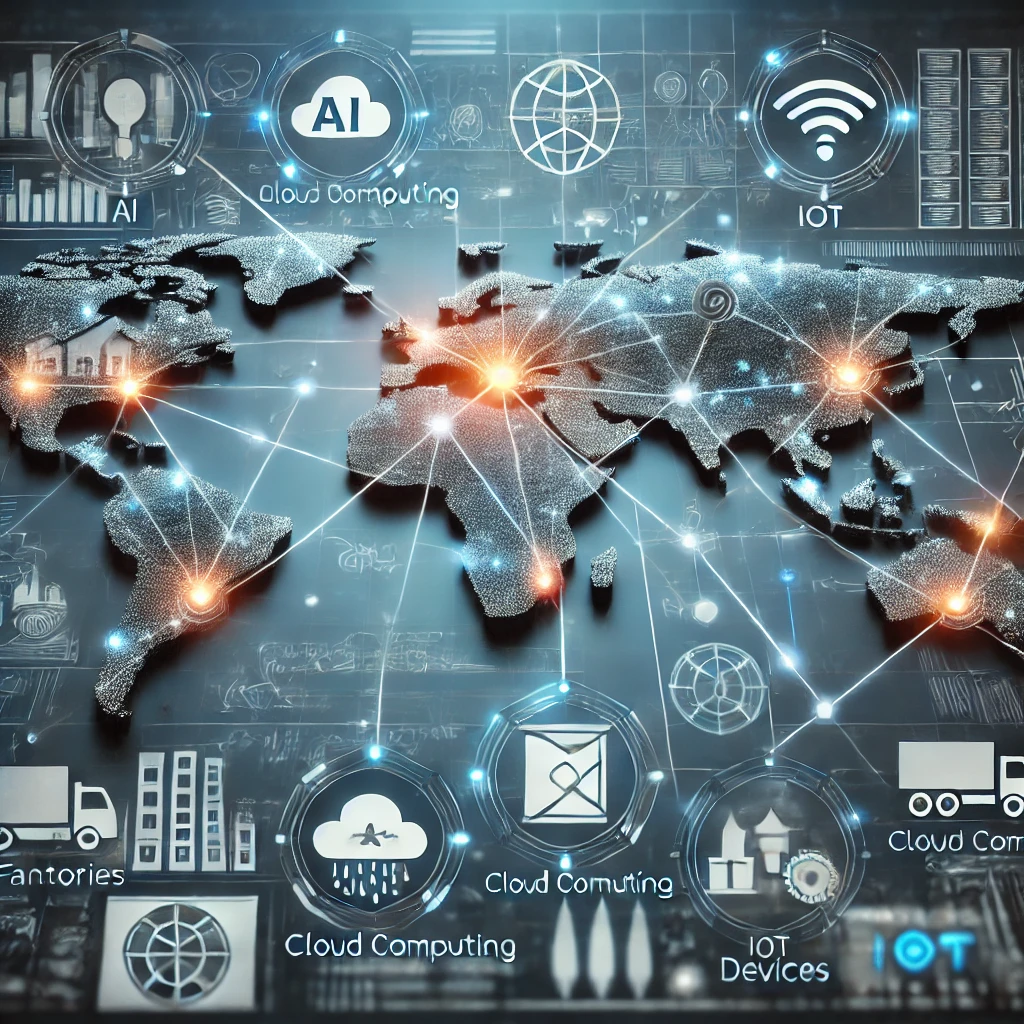
In today’s fast-paced global economy, businesses are constantly seeking ways to optimize their supply chains. Supply Chain Management (SCM) involves coordinating and integrating the flow of goods, information, and finances from raw material suppliers to the end consumer. Information technology (IT) plays a vital role in improving efficiency, transparency, and cost-effectiveness in SCM. With the introduction of advanced technologies such as AI, IoT, and cloud computing, supply chain management has transformed from a simple logistical function to a data-driven, streamlined operation.
1. Enhancing Visibility with Technology
Visibility is one of the critical factors that can make or break a supply chain. Real-time visibility enables businesses to track goods from production to delivery, offering insights into any potential delays or disruptions. Information technology has introduced tools that allow companies to monitor their supply chain at every stage.
Use of Technology to Improve Supply Chain:
- IoT (Internet of Things): IoT devices provide real-time tracking of shipments, inventory levels, and the condition of goods. This ensures products reach their destination on time and in optimal condition. For example, IoT sensors placed in shipping containers can track temperature and humidity, ensuring products such as perishables are kept within specific parameters.
- Cloud Computing: Cloud-based systems provide accessible platforms for data sharing between supply chain stakeholders. This transparency allows for collaboration between suppliers, manufacturers, and retailers, reducing the likelihood of miscommunication and errors.
Read More: How to Build a Shopify Store App Using React Native
2. Leveraging Data with Artificial Intelligence
Artificial Intelligence (AI) has revolutionized supply chain management by improving forecasting accuracy, optimizing inventory levels, and reducing operational costs. AI systems analyze vast amounts of data to predict future demand and manage supply accordingly.
AI Development Services in SCM:
- Demand Forecasting: AI algorithms can analyze historical sales data, current market trends, and external factors like weather conditions or geopolitical events to predict future demand. This enables companies to optimize inventory levels, reducing stockouts or overstock situations.
- Automated Processes: AI-powered robots and software can handle repetitive tasks such as sorting, packing, or routing deliveries. This automation increases productivity while reducing human error.
3. Improving Communication and Collaboration with Cloud Computing
In a globalized world, companies often have multiple stakeholders located in different regions. Communication and collaboration are essential for ensuring the smooth flow of goods and information across the supply chain. Cloud computing has transformed how businesses manage and share information.
Cloud App Development Services for Supply Chain Efficiency:
- Unified Platforms: Cloud-based platforms provide a centralized system for tracking inventory, managing orders, and sharing data. This ensures that all supply chain stakeholders, from suppliers to distributors, have access to the same real-time information, improving decision-making.
- Scalability and Flexibility: Cloud applications can scale with the business, allowing companies to adapt to changes in demand or expand into new markets without the need for significant investments in infrastructure.
4. IoT’s Role in Predictive Maintenance and Asset Management
Predictive maintenance is another area where information technology has transformed supply chain management. With IoT devices, companies can monitor the condition of their equipment and assets in real-time, predicting when maintenance is required before a breakdown occurs.
IoT Development Services for Asset Monitoring:
- Real-Time Monitoring: Sensors on machines and vehicles can provide real-time data on their condition, alerting maintenance teams when a part needs to be repaired or replaced. This reduces downtime and ensures the smooth operation of the supply chain.
- Improved Efficiency: By monitoring the health of critical assets, companies can avoid unexpected breakdowns, leading to fewer delays and interruptions in the supply chain.
5. Optimizing Logistics and Transportation with Advanced Technology
The logistics and transportation components of the supply chain are arguably the most complex and costly. With the integration of IT, companies can optimize their transportation routes, reduce fuel costs, and ensure timely deliveries.
Use of Technology to Improve Supply Chain Logistics:
- AI-Powered Route Optimization: AI systems can analyze traffic data, weather conditions, and delivery schedules to recommend the most efficient transportation routes. This reduces fuel consumption, lowers carbon emissions, and ensures that deliveries are made on time.
- Fleet Management with IoT: IoT sensors installed in delivery vehicles can monitor fuel usage, driving patterns, and vehicle health. This data allows companies to manage their fleets more efficiently, reducing operational costs and improving the overall performance of the supply chain.
6. Data Security and Risk Management
With the increasing reliance on information technology, data security has become a major concern in supply chain management. Cyberattacks or data breaches can disrupt operations, leading to financial losses and damage to a company’s reputation.
Cloud and AI Solutions for Risk Mitigation:
- Secure Cloud Platforms: Cloud app development services provide secure platforms for storing and sharing sensitive supply chain data. With the use of encryption and multi-factor authentication, businesses can protect their data from unauthorized access.
- AI for Risk Assessment: AI systems can analyze potential risks in the supply chain, such as supplier reliability or geopolitical instability, and recommend actions to mitigate these risks. This helps companies avoid disruptions and maintain a smooth flow of goods.
7. Sustainability and Environmental Impact
Sustainability is becoming a top priority for companies and consumers alike. Information technology can help businesses reduce their environmental footprint by optimizing their supply chains for energy efficiency and minimizing waste.
Leveraging Technology for Sustainable Supply Chains:
- AI for Sustainability: AI development services can help companies analyze their supply chains and identify areas where they can reduce waste, improve energy efficiency, or minimize carbon emissions.
- IoT for Energy Management: IoT devices can monitor energy usage in warehouses, factories, and transportation fleets. This allows companies to implement energy-saving measures, reducing their environmental impact.
Conclusion
The role of information technology in supply chain management is undeniable. From enhancing visibility and improving communication to optimizing logistics and ensuring sustainability, IT has transformed supply chains into efficient, data-driven systems. As businesses continue to adopt advanced technologies such as AI, IoT, and cloud computing, the future of supply chain management looks promising, with even more innovations on the horizon.
FAQs
Qus 1. How does AI improve supply chain management?
Ans. AI improves supply chain management by optimizing inventory levels, enhancing demand forecasting, and automating repetitive tasks such as sorting and routing.
Qus 2. What is the role of cloud computing in the supply chain?
Ans. Cloud computing provides a unified platform for data sharing and collaboration, improving communication between supply chain stakeholders and ensuring real-time visibility into operations.
Qus 3. How does IoT help in supply chain management?
Ans. IoT devices provide real-time monitoring of shipments, inventory levels, and equipment health, improving efficiency and reducing downtime through predictive maintenance.
Qus 4. What are the security risks in a tech-driven supply chain?
Ans. Tech-driven supply chains are vulnerable to cyberattacks and data breaches. Implementing secure cloud platforms and AI-based risk assessment tools can mitigate these risks.
Qus 5. How can technology help make supply chains more sustainable?
Ans. AI and IoT can help companies reduce waste, improve energy efficiency, and lower carbon emissions, contributing to more sustainable supply chain practices.

 Software Development
Software Development Food Delivery
Food Delivery Taxi Booking
Taxi Booking E-Commerce
E-Commerce Real Estate
Real Estate Healthcare
Healthcare


